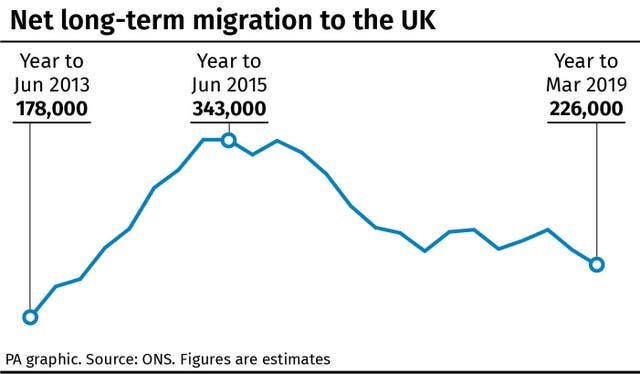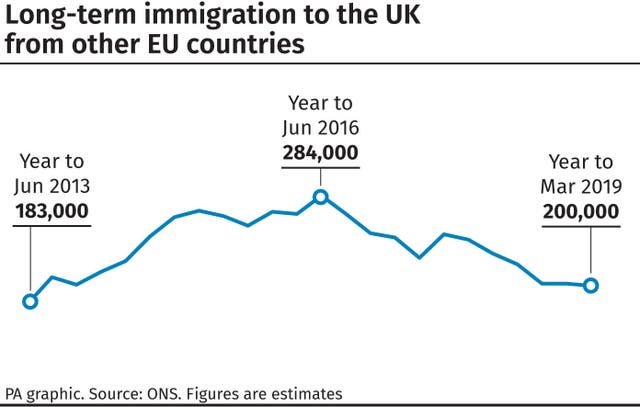
Immigration to the UK from the EU is at its lowest level since 2013, according to the latest estimates.
The number of EU citizens arriving into the UK has continued to fall since 2016, mainly because there has been a drop in people coming to the country for work, the Office for National Statistics (ONS) said when it published its figures on Thursday.
In the year ending March 2019, EU immigration was estimated to be 200,000.
This is the lowest since the year ending June 2013 when it was an estimated 183,000.

An immigration expert at the University of Oxford said the figures showed the UK continues to be a “less attractive destination for EU citizens than it was before the referendum vote”.
But Immigration Minister Seema Kennedy insisted the statistics showed “highly skilled workers continue to be attracted to the UK”.
The figures are classed as experimental estimates and come a day after the ONS admitted it had been underestimating some EU net migration data since 2016.
The error affected figures on the number of migrants from EU8 countries such as Poland since 2016, while migration from countries outside the EU has been overstated, the ONS said.
As a result, due to concerns over accuracy, it has been forced to downgrade the status of its immigration data from national statistics – which require a high degree of reliability – to experimental.

Net migration has remained broadly the same since the end of 2016, according to the ONS.
Around 226,000 more people are thought to have come to the UK with an intention to stay for 12 months or more than left in the year ending March 2019.
This is thought to be lower than the recent peak of 343,000 in the year ending June 2015.
The estimates are based on calculations for net migration incorporating Department for Work and Pensions and Home Office data, the ONS said.
For the past year, net migration estimates have shown more so-called EU8 citizens leaving than arriving.
In the latest period, there were 7,000 more nationals from the EU8 states – Czech Republic, Estonia, Hungary, Latvia, Lithuania, Poland, Slovakia and Slovenia – who left the UK than arrived.
Madeleine Sumption, director of the University of Oxford’s Migration Observatory, said: “The drop in the value of sterling has made working in the UK less lucrative than it once was, and continued uncertainty about the Brexit may also have played a role.
“The picture is different for non-EU nationals, though.
“Non-EU students and skilled workers have continued to migrate to the UK more or less as before.”
She added: “ONS has improved its methods for estimating migration patterns, which is why some of the figures have been revised.
“This means the statistics are now likely to be more robust than they were in the last few years. But it’s still very much a work in progress.
“The new figures will probably be revised again, which is one reason they have been reclassified as experimental statistics rather than the highest quality national statistics.”
Jay Lindop, director of the ONS Centre for International Migration, said: “Our best assessment using all data sources is that long-term international migration continues to add to the UK population.
“The level has been broadly stable since 2016 but there are different patterns for EU and non-EU citizens.
“Using the data sources available to us, we can see that EU immigration is falling.
“There are, however, still more EU citizens moving to the UK than leaving, mainly for work, although the picture is different for EU8 citizens, with more leaving the country than arriving.
“In contrast, non-EU immigration has stabilised over the last year, after gradual increases since 2013.”


Comments: Our rules
We want our comments to be a lively and valuable part of our community - a place where readers can debate and engage with the most important local issues. The ability to comment on our stories is a privilege, not a right, however, and that privilege may be withdrawn if it is abused or misused.
Please report any comments that break our rules.
Read the rules hereLast Updated:
Report this comment Cancel